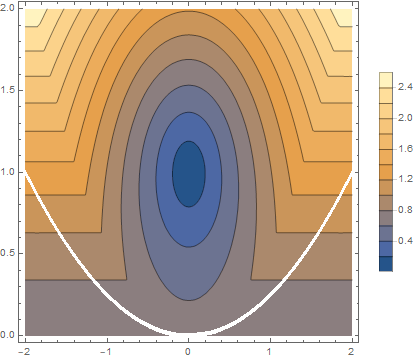There are some words " implicitly solving a transcendental equation?" in the question of Terry Tao. I want give a weak edition " explicitly solving a transcendental equation?" The method shown below suits 'Riemannian surfaces with an explicit distance function?' too. I don't know if it's a useful idea.
If we denote multivariate function composition $f (x_1, \ldots, x_{i-1}, g(x_1, x_2, \ldots, x_n), x_{i+1}, \ldots, x_n)$ like (f.g) for unary function composition as following three forms,
1 $(fC_{i}g)(x_{1},\cdots,x_{n})$ like an operation
2 $[C_{i}(f,g)](x_{1},\cdots,x_{n})$ like a function
3 $[C_{i}\frac{f}{g}](x_{1},\cdots,x_{n})$ like a fraction
For example,equation $x+x^{a}=b$,the left of it is $x+x^{a}$. It can be obtained by substituting $x_{1}$ in $x+x_{1}$ by $x^{a}$,so
$x+x^{a}=[f_{a}C_{2}f_{p}](x,a)$
$x+x^{a}=[C_{2}(f_{a},f_{p})](x,a)$
$x+x^{a}=[C_{2}\frac{f_{a}}{f_{p}}](x,a)$
In which $f_{a}(x_{1},x_{2})=x_{1}+x_{2}$ and $f_{p}(x_{1},x_{2})=x_{1}^{x_{2}}$
$C_{2}(f_{a},f_{p})$ is a binary function. If we define inverse binary function like define it to power operation $f_{p}$,
$z=f_{p}(x,y)=x^{y}$, $x=[I_{1}(f_{p})](z,y)=f_{r}(z,y)=\sqrt[y]{z}$ and $y=[I_{2}(f_{p})](x,z)=f_{l}(x,z)=\log_{x}z$,
In which $f_{r}(z,y)=\sqrt[y]{z}$ and $f_{l}(x,z)=\log_{x}z$. We can extend $I_{i}$ to multivariate functions.
$C_{2}(f_{a},f_{p})(x,a)=b$ then $x=\{I_{1}[C_{2}(f_{a},f_{p})]\}(b,a)$.
Is this " explicitly solving a transcendental equation"?
If you answer 'yes',let us solve $x^{a}+x^{b}+x^{c}=d,(a,b,c,d\geq0)$
$f_{a2}{\{}f_{a1}[f_{p1}(x,a),f_{p2}(x,b)],f_{p3}(x,c){\}}=d,$
There are more than one additions or powers so we distinguish them by their subscript.
First,there are four parameters,x,a,b,c. So we obtain:
$f_{p1}(x,a)=P^4_{1,2}(f_{p})(x,a,b,c)$,
$f_{p2}(x,b)=P^4_{1,3}(f_{p})(x,a,b,c)$,
$f_{p3}(x,c)=P^4_{1,4}(f_{p})(x,a,b,c)$,
$f_{a1}(x_{1},x_{3})=P^4_{1,3}(f_{a})(x_{1},x_{2},x_{3},x_{4})=x_{1}+x_{3}$,where $ x_{1}$ or $ x_{3}$ is transitional variable.
$f_{a2}(x_{3},x_{4})=P^4_{3,4}(f_{a})(x_{1},x_{2},x_{3},x_{4})=x_{3}+x_{4}$, where $ x_{3}$ or $ x_{4}$ is transitional variable.
$P^n_{i,j}$ is called function promotion, take $P^3_{1,3}$ as an example, $[P^3_{1,3}(f_{a})](x_{1},x_{2},x_{3})=x_{1}+x_{3}+O(x_{2})=f_{a}(x_{1},x_{3})+O(x_{2})$,where $O(x)\equiv0$.That is say $P^n_{i,j}$ change a binary function f to a especial function of n variables and take two variables of f as the i-th and j-th variable of $P^n_{i,j}(f)$ respectively.
Substituting $P^4_{1,2}(f_{p})$ to $x_{1}$ and $P^4_{1,3}(f_{p})$ to $x_{3}$ of $P^4_{1,3}(f_{a})(x_{1},x_{2},x_{3},x_{4})=x_{1}+x_{3}$ respectively,
$C_{1}[P^4_{1,3}(f_{a}),P^4_{1,2}(f_p)]$.
$C_{3}{\{}C_{1}[P^4_{1,3}(f_{a}),P^4_{1,2}(f_p)],P^4_{1,3}(f_p){\}}$.
Substituting $C_{3}{\{}C_{1}[P^4_{1,3}(f_{a}),P^4_{1,2}(f_p)],P^4_{1,3}(f_p){\}}$ to $x_{3}$ and $P^4_{1,4}(f_{p})$ to $x_{4}$ of $P^4_{3,4}(f_{a})(x_{1},x_{2},x_{3},x_{4})=x_{3}+x_{4}$ respectively,
$C_{3}\frac{P^4_{3,4}(f_{a})}{C_{3}{\{}C_{1}[P^4_{1,3}(f_{a}),P^4_{1,2}(f_p)],P^4_{1,3}(f_p){\}}}$.
$C_{4}[C_{3}\frac{P^4_{3,4}(f_{a})}{C_{3}{\{}C_{1}[P^4_{1,3}(f_{a}),P^4_{1,2}(f_p)],P^4_{1,3}(f_p){\}}},P^4_{1,4}(f_{p})]$.
This is the structure of the left of the equation $x^{a}+x^{b}+x^{c}=d$ described by multivariate function composition .The equation will be:
${\{}C_{4}[C_{3}\frac{P^4_{3,4}(f_{a})}{C_{3}{\{}C_{1}[P^4_{1,3}(f_{a}),P^4_{1,2}(f_p)],P^4_{1,3}(f_p){\}}},P^4_{1,4}(f_{p})]{\}}(x,a,b,c)=d$
The expression for the solution of the equation is:
$x=I_{1}{\{}C_{4}[C_{3}\frac{P^4_{3,4}(f_{a})}{C_{3}{\{}C_{1}[P^4_{1,3}(f_{a}),P^4_{1,2}(f_p)],P^4_{1,3}(f_p){\}}},P^4_{1,4}(f_{p})]{\}}(d,a,b,c)$
For such an expression $I_{3}{\{}C_{4}[C_{3}\frac{P^4_{3,4}(f_{a})}{C_{3}{\{}C_{1}[P^4_{1,3}(f_{a}),P^4_{1,2}(f_p)],P^4_{1,3}(f_p){\}}},P^4_{1,4}(f_{p})]{\}}$,we never mind how complex it is. We consider it as a multivariate function being composition results of two other multivariate functions being composition results and/or promotion results.


